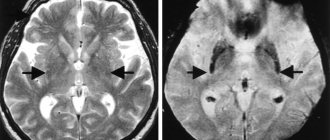Pain Treatment Center
Alekseeva
Oksana Alexandrovna
23 years of experience
Doctor, highest qualification category, member of the European Association of Neurologists, Russian Interregional Society for the Study of Pain (ROIB), Association of Interdisciplinary Medicine. Has experience working in hospital and outpatient services. He has seven published works on neurology.
Make an appointment
The term “neurosis” is usually used to designate a whole group of pathologies, which are based on temporary reversible mental disorders caused by excessive load on the basic nervous processes - excitation and inhibition. Neuroses are functional diseases that are not based on structural disorders. They arise as a result of a severe conflict within the individual or changes in particularly significant life relationships of a person and are manifested by exclusively mild neurotic symptoms and somato-vegetative deviations.
According to academician V.P. Pavlov, neurosis is a breakdown of higher nervous activity that occurs when the normal course of basic nervous processes, their relationships, strength and mobility changes. That is, this is a violation of higher nervous activity and neurovegetative functions, developing under the influence of mental trauma or prolonged emotional stress. It manifests itself primarily in the emotional sphere, while the state of affect provokes changes in thinking and general behavior.
This condition lasts from several days to several years. At the same time, the patient maintains a critical attitude towards the disease, there are no violations of social adaptation. People with melancholic and choleric types of temperament are more likely to suffer from neuroses, while sanguine and phlegmatic people suffer from them much less often.
A characteristic feature of all neuroses is the fact that a person is often aware of the meaninglessness of his symptoms (panic, fear, etc.) or the absence of grounds for somatic symptoms, but still feels anxiety associated with them. It is the patient's criticism of his symptoms that distinguishes neuroses from psychoses.
It should be noted that in the 10th edition of the International Classification of Diseases (ICD-10), the word “neurosis” is not used, and the dominant symptomatology became the basis for the classification of the corresponding group of mental diseases. Thus, some traditionally neurotic disorders belong to “eating disorders”, others to “sleep disorders of an inorganic nature”, etc.
But, despite the fact that the concept itself is gradually disappearing from the terminology of clinical diagnostics, it still remains widely used in psychological practice and the theoretical works of many authors. The concept of neurosis is still useful today when constructing a strategy for psychological support in the psychological service system.
The concept of neurosis unites a whole group of mental disorders with very different symptoms from all organs and systems. This includes a set of psychogenic, emotional and physiological disorders.
Symptoms and signs
Neuroses are characterized by dynamic and varied psychopathological and somatic symptoms against the background of insufficient mental defense. This is accompanied by the formation of a conflict, manifested by disturbances in different areas (emotional, vegetative, endocrine, etc.). There are main groups of clinical symptoms inherent in all types of neuroses, this includes disorders from:
1. self-control:
- discomfort;
- headache;
- feeling of weakness (especially after sleep);
- increased fatigue;
- decreased ability to work;
- prostration.
2. emotions:
- changeability (lability) of mood, irritability;
- tendency to depressive reactions, fears, obsessive concerns;
- violent affective outbursts followed by exhaustion;
- inadequacy of the emotional reaction to the strength of the stimulus;
- lack of control over emotions.
3. volitional sphere and drives:
- loss of appetite;
- sexual function;
- obsessive urges and actions;
- insufficient control of behavior.
4. somatovegetative system:
- hyperhidrosis (excessive sweating), hot flashes;
- increased dermographism (change in skin color, rash);
- tachycardia (rapid heartbeat), changes in blood pressure and pulse;
- constipation, nausea;
- frequent urination, enuresis;
- stuttering;
- tremor (shaking) of the body.
With each type of neurosis, especially its manifestation (vivid manifestation), an arbitrary number of the above symptoms may occur. In the process of further development of the disease, depending on personal characteristics, violations of mental or somatovegetative functions come to the fore.
The development of a certain type of disease significantly depends on the type of higher nervous activity (HNA). Individuals with an artistic type, in whom the first signaling system (subcortical processes) dominates the second (cerebral cortex), often experience hysterical neurosis. Individuals with the mental type GND are prone to obsessive-compulsive neuroses when the second signaling system prevails over the first. Most people have a mixed type of GND; most often they experience neurasthenia.
Are you experiencing symptoms of neurosis?
Only a doctor can accurately diagnose the disease. Don't delay your consultation - call
Differences from a neurologist and a psychiatrist
Neurologist, neuropathologist and psychiatrist: the similarity between these terms is as follows - they all refer to specialists with higher medical education. However, the list of diseases that doctors treat, as well as approaches to treatment and management of patients, differ significantly.
A psychiatrist works exclusively with mental problems, without touching physiology. The main effect is medicinal. A psychiatrist is involved in therapy when mental disorders develop against the background of neurological pathology (for example, with Alzheimer's disease).
Neuropathologist is an outdated name for the specialty "neurologist", used in the 70s and 80s, but is no longer used.
Neurasthenia
It is characterized by the presence of diverse symptoms: somatic, neurological, psychopathological. Somatic symptoms are not associated with any disease of the internal organs, but are often so pronounced that they force the patient to constantly contact the appropriate doctors. Mainly observed manifestations of dysfunction of the cardiovascular system, tachycardia, sometimes slowing of the pulse, a feeling of pain, freezing or compression in the heart area. Sometimes there is dysfunction of the digestive tract: decreased or “crankiness” of appetite, nausea, upset stool. With neurasthenia, the symptoms of neurosis in women are expressed by abnormalities in the menstrual cycle. Neuroses in men are characterized by signs of impotence (various forms of impaired sexual desire and erection).
Common symptoms include hyperesthesia (increased sensitivity) to external stimuli (light, sound, etc.), poor health, which is difficult for patients to describe. There is a feeling of heaviness in the head (“cloudy head”), headache of undetermined localization, and dizziness. There are problems with sleep: falling asleep takes a long time, frequent awakenings, sleep is not deep enough, which means it does not bring pleasure and a feeling of rest, even if its duration is sufficient.
The neurological status shows increased tendon reflexes, tremor of extended limbs, severe sweating and other signs of irritation of the autonomic nervous system.
The psychopathological symptoms of neurasthenia are well described by the term “irritable weakness” - increased excitability is combined with rapid fatigue. A bad mood and emotional lability are inherent, which, unlike that in hysteria, is accompanied by rapid depletion of nervous processes. Emotional “explosions” begin easily, due to an insignificant reason. After them, the patient begins to repent of his behavior and feel awkward. Tearfulness is typical, even for neuroses in men, and imbalance when communicating with others. Working capacity, in particular mental, is reduced, but often a person, under the influence of tonic mental factors, can “pull himself together” and complete the required amount of work.
With neurasthenia there are no qualitative intellectual impairments. Patients complain of forgetfulness, poor memory in everyday life, and worry about this. Such manifestations are the consequences of impaired attention and poor concentration, but they pass without a trace.
There are two forms of neurasthenia: hypersthenic and hyposthenic. Hypersthenic is characterized by a predominance of symptoms of irritable weakness, and hyposthenic is characterized by asthenia of the nervous system (general weakness, lethargy, intolerance to any irritants and stress, decreased vitality).
Neuroticism
Neurasthenia has been used to describe diseases in which the nervous system does not function properly and no lesion can explain the dysfunction. This is a long-term tendency to be in a negative or anxious emotional environment. This is a personal individual characteristic of a person. Many people confuse it with neuroses, but it is a trait, not a disorder, that constitutes a personality model. Such obscurations, if they reduce the quality of life, are corrected by psychotherapy.
Psychosis or neurosis?
In a state of psychosis, a person ceases to rationally perceive reality and interpret it. He sees and experiences differently than those around him. This impairs the ability to function normally in the social sphere. Symptoms include hallucinations and delusions. The manifestation can begin with the most imperceptible signs for others and the patient himself, or “collapse” immediately. They may be a complex mental or neurological disorder. It can also occur due to improper use of medications, consumption of alcohol, drugs, or as a harbinger of acute poisoning or infectious disease. In recent years, scientists have questioned the distinction between neurosis and psychosis, since the former may be a precursor.
Obsessive-compulsive disorders (OCD)
They are demonstrated by a feeling of fearfulness, intimidation, and anxiety. Obsessive thoughts haunt the patient against his wishes and will, although they are assessed by him as meaningless and harmful. There are syndromes of the following obsessive states:
- doubts – uncertainty about the correctness of actions taken or not taken, contrary to logical arguments. Such a person doubts whether he turned off electrical appliances, closed the door, whether the document was written correctly, etc., although he has repeatedly checked the action performed;
- Memories are annoying pictures of the past. Often a sad, unpleasant or shameful incident for the patient, and he tries not to think about it;
- imagination - the emergence of implausible images, perceived as real despite their absurdity. There may be a belief that the buried relative was alive, or other similar misconceptions. In this case, the patient imagines and painfully experiences the suffering of the “obviously dead” person in the grave or other unpleasant feelings;
- drive - a desire to carry out some extremely undesirable action, accompanied by horror and panic due to the impossibility of freeing oneself from such a desire. For example, it covers the desire to harm a loved one, throw yourself under a train, a car, or push someone under it. At the same time, an unbearable fear is experienced that this is happening (contrasting attraction);
- phobias (fears) - an unreasonable fear of heights, open or confined spaces, crowds of people, sudden death, etc. Sometimes they are accompanied by rituals - monotonous actions that have the meaning of spells and amulets. Such actions are performed with the aim of protecting against a certain misfortune, despite the critical attitude towards them. So, by walking around the arch, instead of passing under it, a person seems to be saving his relatives from harm; when starting something, he snaps his fingers twice or says the “cherished” word out loud - in order to avoid failure.
Some obsessive actions fill the patient’s thoughts until they are implemented, others pass and are forgotten. To keep himself from becoming obsessed, he needs to constantly monitor himself, which is extremely tiring for him.
Close to obsessional neurosis in clinical terms are psychasthenia and psychasthenic neurosis. They are characterized by:
- predominance of asthenia (enduring fatigue, weakness);
- constant general feeling of tension with heavy foreboding;
- conviction of personal social inadequacy, ugliness and inferiority relative to others;
- excessive impressionability due to criticism addressed to oneself;
- reluctance to make contact without a guarantee of being liked;
- avoidance of social or professional activities associated with significant social contacts due to fear of criticism, disapproval, or ignorance;
- limited life and social way of life due to the need for physical and psychological safety.
Differential diagnosis is necessary to distinguish obsessional neurosis from schizophrenia, cerebral atherosclerosis, and the consequences of encephalitis. The distinctive feature of neurosis, and at the initial stage the only psychopathological symptom, will be obsession. There are no intellectual disorders. If the disease takes a long course and is not sufficiently treatable, it can affect the patient’s personality and his future fate.
Reminder before your appointment
What can you do before your appointment?
Before visiting a doctor, you should not take tests or submit instrumental studies - after the examination, the doctor may decide that he needs completely different examinations than those completed before the appointment.
In general, what can be done first based on complaints:
- headaches - MRI of the brain;
- pain in the spine - x-ray or MRI of the corresponding department;
- sensitivity disturbance, numbness, tingling, crawling sensation - blood test for sugar, ENMG/ENG;
- visual impairment - consultation with an ophthalmologist;
- pain in the face, jaw - examination by a dentist;
- impaired sense of smell - visit to an ENT doctor.
What does a neurologist ask about at an appointment?
To clarify the picture of the disease, the doctor will ask questions. Things to remember before taking:
- when did the first complaints appear?
- whether the dynamics were in the direction of increasing or decreasing the severity of symptoms;
- Do relatives have similar problems?
- whether any preliminary examinations were carried out;
- individual intolerance to drugs, products;
- What treatments have you tried – which remedies helped and which didn’t.
There is no need to worry - the doctor himself will ask the patient about everything to get the necessary information. But excessive anxiety, on the contrary, will reduce the information content of the conversation.
What people most often forget to mention at the reception:
- prerequisites for the onset of the disease, i.e. what, in the patient’s opinion, could provoke the development of symptoms;
- presence of injuries, operations;
- the use of drugs prescribed by a doctor of another specialty - this is important to determine the compatibility of drugs.
A neurologist is a doctor who treats a large number of pathologies associated with dysfunction of the brain, spinal cord or nerve fibers. To make a final diagnosis, the patient is sent for additional instrumental and laboratory examinations. The sooner a person seeks medical help, the higher his chances of recovery.
Hysterical neurosis
The clinical picture of hysteria is characterized by increased lability of emotions and the transition of the mental component to the somatoneurological one. This is the only form of neurosis when qualitative changes in consciousness are possible. Almost all symptoms of hysteria are protective for the patient, corresponding to a specific psychotraumatic situation. They bring a certain moral benefit to the individual, since they provide an opportunity to get rid of another difficult experience. Therefore, hysteria can be considered as a kind of protective phenomenon that occurs under the influence of a super-powerful stimulus.
Example: a mother received unexpected news about the tragic death of her son; while waiting for the body to be brought, she thought with horror that she would not be able to see him dead, and suddenly became blind; After a while, the hysterical blindness passed.
Emotional lability during hysteria manifests itself in a sharp change in emotions and their inconstancy. But, unlike neurasthenia, they are indicated by high intensity and duration. The patient, who a minute ago was crying bitterly and in deep despair, without much effort not only calms down, but also easily comes into a good mood. Such lability of emotions leads to instability in desires, intentions, behavior, likes and dislikes. In addition to emotional lability, a clear symptom of hysteria is easy suggestibility - both self-suggestion and the ability to be suggested by others.
The most striking reaction to a stimulus from the motor system will be a hysterical attack. Seizures do not occur when no one is near the patient, and are not accompanied by a sharp fall with bruises and injuries. Movement disorders have a pronounced neurotic character and coincide with the content of the patient’s experiences. He falls, chaotically swings his arms and legs, hits them on the floor, bends over, shouts out individual words. The seizure lasts from several minutes to hours. Unlike epileptic paroxysm, hysterical paroxysm is not accompanied by a clear violation of muscle tone, spasm of the sphincters with their relaxation and incontinence of urine and feces, the reaction of the pupils to light is preserved, and treatment is perceived adequately. After the attack, only a vague memory of it remains.
One type of hysteria is a disorder of consciousness under the influence of mental trauma. The perception of the surrounding reality is distorted. Behavior takes on childlike features, helplessness, and elements of fake dementia - pseudodementia. Some experience neurological symptoms: decreased sensitivity, trembling hands, hysterical deafness or muteness.
Significant strength and lability of emotions can sometimes cause a deviation of consciousness such as twilight stupefaction (hysterical delirium) and painful constriction (hysterical unconsciousness). The twilight state of hysteria usually demonstrates a pure type of painfully narrowed consciousness without stupor or other signs of its disturbance.
Symptoms for which you can contact a neurologist
Patients often underestimate the severity of their condition or do not know what signs indicate it is time to seek medical help. In some cases, this worsens the prognosis and leads to the disease becoming chronic. Some symptoms at first glance seem insignificant, but are actually very serious - a list of complaints that serve as a reason to contact a neurologist:
- dizziness;
- headache;
- noise in ears;
- memory and attention impairment;
- insomnia;
- drowsiness;
- weakness in arms, legs.
More serious manifestations of neurological disorders:
- urination disorder;
- fecal incontinence or constipation;
- pain in the back, limbs, especially fingers, face;
- disturbance of any kind of sensitivity on the skin;
- impairment of vision, hearing, taste, smell, touch;
- double vision;
- loss of balance;
- loss of consciousness;
- tremor (shaking) of the hands, head, legs;
- swallowing disorders;
- seizures;
- paralysis of a body part.
The listed symptoms do not always indicate a neurological disease, but they definitely require examination by a neurologist.
Does a neurologist treat depression, panic attacks?
Yes, a neurologist has the right to prescribe medications for these conditions if the patient came to the appointment with relevant complaints or the symptoms were identified during the conversation. Suspicious, impressionable young people often come to the doctor with panic attacks, depressed mood or excessive excitability. The joint work of a neurologist and a psychotherapist will be useful for them.
Exceptions include persons who have warning signs - thoughts of suicide, harm to others, obsessive ideas or movements, or previously identified mental illness. In such cases, the neurologist is not a competent specialist, so he refers to a psychiatrist or psychotherapist.
Can a neurologist prescribe antidepressants?
The doctor has the right to prescribe antidepressants on a prescription form if the patient’s condition requires it.
Neurotic depression
Neurotic depression is typically characterized by a depressed state with some inhibition of psychomotor reactions and thinking. There are monotonous depressive memories, pessimistic views of the future, and fixation on the traumatic situation. There is a tendency to tearfulness, irritability, decreased appetite, sleep disturbance, sensitivity (excessive emotional sensitivity).
Neurotic depression does not reach the depth of psychosis, is reversible, and goes away when a traumatic situation is analyzed or under the influence of treatment.
Causes
The main causes of neuroses are mental trauma and stress. They can be provoked by certain life circumstances, diseases, alcohol or drug use.
A neurotic breakdown is possible for any person, but its nature and form are determined by a whole group of factors. On the one hand, the formation of neurosis depends on the individual characteristics of the individual, hereditary selective tolerance to external influences, and the level of adaptive capabilities of the body. On the other hand, the occurrence of a particular neurosis is determined by the nature of the mental trauma. It can be sudden (death of a loved one) or arise as a result of long-term unfavorable conditions (conflict and tension in the family, at work).
But such situations do not always lead to neurosis. It all depends on how important it is to a person and how he feels about it. Favorable factors include mental trauma suffered in childhood, upbringing in a negative environment, and frequent somatic illnesses.
Diagnostics
In each specific case of a neurotic disorder, a varied pattern of symptoms of different types of neurosis may be demonstrated. All this can be accompanied by various symptoms of mental and somatic disorders, which creates certain difficulties in diagnosis. Therefore, the qualifications of the attending physician, his medical experience and professional skills are so important.
The collected anamnesis is of great importance - the patient’s complaints, his description of the nature and intensity of the symptoms, the time of their manifestation. It will also be important to talk with loved ones, since they can often provide valuable information. Medical observation in a hospital setting may be required to confirm or refute the diagnosis.
It is necessary to carefully check the level of hormones in the body, since the development and course of depression or neurosis are strongly influenced by hormones. This is especially true for thyroid hormones; even minor changes in their levels, which are difficult to detect using conventional tests, can have a very significant effect on well-being. If a hormonal imbalance is detected, proper hormonal therapy must be initiated. In some cases, normalization of thyroid function leads to a complete cure for neurosis.
Differentiated diagnosis is important when you need to be able to distinguish one pathology from another. Provided that neuroses are often accompanied by somatic symptoms, the doctor will prescribe an appropriate examination. In addition to general laboratory tests (blood, urine), specific studies (hormonal levels) may be required. If a brain disorder is suspected, magnetic resonance imaging (MRI) or computed tomography (CT) is recommended.
Restoring normal life
It will consist not only of nutrition, exercise and the elimination of provoking factors. It is important that the patient monitors his health, avoids stressful situations, gets good sleep and avoids excessive stress. When the original cause has already been eliminated, a lot will depend on the person himself - his desire to get rid of the symptom and return to normal life.
As solutions that will help the patient establish the desired lifestyle, the Kuntsevo Medical and Rehabilitation Center offers physical therapy, physiotherapy, and massage. Many of the procedures are aimed not only at a specific problem, but also at increasing the level of happiness hormones - and this is important when treating panic attacks.
Treatment
You need to know: all psychogenic disorders in neurosis are reversible, that is, they are completely curable! Since the main cause of pathology is internal conflicts in the human subconscious, the first priority for the successful treatment of neurosis will be to eliminate the traumatic situation, stress, or mitigate the reaction to them. Excluding the patient from traumatic circumstances (family troubles, conflict at work, etc.), they are analyzed. The next steps will be the use of treatment methods based on drug therapy and psychotherapy.
What does a neurologist treat in children?
A pediatric neurologist will help with:
- developmental delay;
- attention deficit symptom;
- Down syndrome;
- hyperactivity;
- convulsions and fainting;
- epilepsy;
- polio;
- hydrocephalus;
- phenylketonuria;
- West syndrome;
- cerebral palsy;
- birth and hypoxic lesions.
The specialist also monitors infants, which allows timely detection and elimination of the slightest pathologies.
Drug therapy
The course of neurosis is associated with a simultaneous decrease in the level of brain serotonin, therefore long-term use of antidepressants - selective serotonin reuptake inhibitors - is prescribed for treatment. At the initial stage of treatment with antidepressants, their adverse reactions may occur, and the patient’s condition may worsen. In view of this, it is important not to stop taking the prescribed treatment, but only to reduce the dose of the drugs. Then, as tolerance improves, the dosage is gradually increased to the recommended values. Over time, the symptoms of neurosis decrease and the patient's condition improves.
Important: the antidepressant must be selected by a doctor! The selection takes into account the individual tolerability of the drug and its effectiveness for specific neurotic symptoms.
For the treatment of neuroses accompanied by insomnia or poor sleep, sedative and hypnotic antidepressants are prescribed. Sometimes, with great caution and in small doses, in short courses (to avoid addiction), tranquilizers are prescribed. When treating neuroses with concomitant weakness, memory loss, and asthenia, nootropic drugs are used. The duration of treatment is usually several months; if necessary, the course must be repeated.
Lifestyle during panic attacks
It is important for people who suffer from such symptoms to remember that they do not go away on their own—the situation will only get worse over time. At the same time, each time the body will experience enormous stress - an untimely sense of danger forces it to work at “maximum speed”. The sooner the patient begins a thorough examination and, with the help of doctors, discovers the causes, the less risk there is of aggravating the situation and causing additional illnesses.
Contact the Kuntsevo Treatment and Rehabilitation Center - they will help you!
Psychotherapy
In order to alleviate neurotic symptoms (by taking antidepressants), psychotherapy is carried out:
- Cognitive-behavioral therapy – formation in the patient of the correct reaction to the situation, strengthening his adequate assessment of his behavior in a traumatic situation, changing the way he responds to it;
- group psychotherapy – takes place for 1.5 hours daily or weekly, in the form of discussions. Topics are determined in advance; they relate to the biography, behavior of group members, and life situations. Group therapy has rules: strict confidentiality, sincerity of participants, experience “here and now,” specificity of topics. Groups can be closed - with a constant composition of participants, or open - someone comes, someone stops visiting;
- hypnotherapy - suggestion is carried out in a special state of the patient, hypnotic. The session includes 4 stages: hypnotization, therapeutic suggestion, therapeutic rest, dehypnotization;
- autogenic training;
- breathing exercises for relaxation and concentration;
- non-verbal methods of psychotherapy - music therapy, art therapy, dancing and pantomime.
The most effective treatment is a combination of antidepressant medication and cognitive behavioral therapy.
How is an examination by a neurologist performed?
A consultation with a specialist begins with a conversation with the patient. The doctor listens carefully to his complaints, looks at his general condition, examines his medical history and medical certificate. During the examination, the doctor first of all pays attention to the functioning and functioning of the patient’s nervous system. An experienced neurologist can only draw a conclusion about the patient’s state of health based on movements, gait and coordination, however, this is not enough for an accurate medical conclusion.
The doctor conducts a visual and tactile initial examination of the patient, studies unconditioned reflexes, conducts visual examination and palpation. At this stage, possible pathologies in the sensory and motor functioning of the body are identified. A neurologist examines the activity of the optic nerve using a hammer, examines the patient’s facial expressions, analyzes reflex reactions, diagnoses the presence or absence of asymmetries of the patient’s face and body, assesses the state of memory, and generally examines the patient’s coordination of movements and motor skills.
To significantly facilitate the diagnostic process and ensure the correctness of the doctor’s medical report, the following tests can be performed on the patient: a general blood test, x-ray, magnetic resonance therapy of the brain, Doppler ultrasound of the neck and head, electroencephalography, electroneuromyography, biopsy of muscles and nerve tissues.
Also, to obtain a complete picture of the disease and the patient’s condition, consultation with an endocrinologist, ophthalmologist, cardiologist and other specialists may be required.
What doctors treat neuroses
Psychiatrists, psychotherapists and psychoneurologists play a leading role in the treatment of neuroses. Doctors of many specialties also take part in the treatment process: therapists, cardiologists, gastroenterologists, neurologists, etc.
Such a large list of specialists is explained by the need for accurate diagnosis while simultaneously excluding other pathologies. Quite often, neurosis is disguised as symptoms of neurocirculatory dystonia, insomnia (insomnia), migraine, vestibulopathy and many other diseases. To definitely confirm or refute a particular diagnosis, the participation of a specialized specialist is required.
What diseases does the specialist deal with?
Let's try to find out when a neurologist will help, what he treats in adults.
The doctor treats neurological disorders:
- intracranial hypertension;
- nervous tics, tremors;
- cranial and spinal injuries, as well as their consequences;
- Alzheimer's and Parkinson's diseases;
- multiple sclerosis;
- stroke and its consequences;
- paresis and paralysis;
- neuralgia, neuritis, plexitis;
- migraines, headaches;
- pain in the neck and back;
- painful prolapses caused by nerve damage;
- seizures, epilepsy;
- cauda equina syndrome;
- torsion dystonia;
- encephalopathy;
- osteochondrosis;
- radiculitis;
- intervertebral hernia;
- Wilson-Konovalov disease;
- Crouzon and Dandy-Walker syndromes;
- arachnoiditis;
- leukodystrophy;
- myasthenia gravis;
- neurofibromatosis;
- blepharospasm;
- syringomyelia;
- vertebrobasilar insufficiency;
- meningitis, encephalitis;
- insomnia;
- sleep apnea syndrome;
- tumors of various etiologies.
The listed diseases are often accompanied by changes in mentality and behavior. In this case, it may be necessary to consult a psychiatrist or psychotherapist.
Advantages of treatment at the clinic of JSC "Medicine"
The course of neurosis does not lead to disability, but often disrupts the full life of the patient and people close to him. In modern medicine, there are 3 stages of development of neuroses. The later the stage, the more difficult the treatment; this must be clearly understood. Medical specialists (academician Roitberg’s clinic) successfully treat neuroses in adults and children at any stage of complexity.
Remember: it is impossible to cure neurosis on your own, but in the conditions of the clinic of JSC “Medicine” it is absolutely possible to recover completely! Leading specialists of domestic medicine, including academicians, professors, doctors and candidates of medical sciences, conduct receptions here. Modern material and technical base, coupled with the professionalism of doctors, allows patients with neuroses to recover in the shortest possible time!
Neurologists
Good Elena Dmitrievna
★ Successfully treats motor dysfunction and relieves pain syndromes
Neurologist
doctor of the highest category
Diamed Mitino
We are waiting for you if you are worried about neuroses. Our clinics are located within walking distance from metro stations. We work seven days a week. We accept cash and bank cards for payment.
The causes of neuroses in adults lie in the stress on the body and stress factors. Chronic stress leads to overload and exhaustion. Nervous breakdowns of this kind usually affect those who are unable to experience increased stress for a long time.










